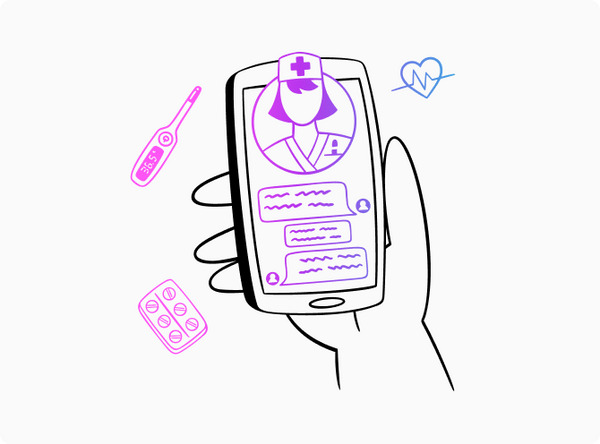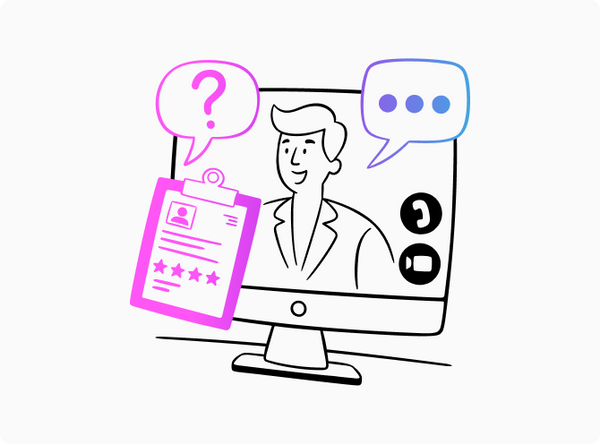
The Requirements and Process for Developing an MVP for Telemedicine App
 Daria Taranets
Daria TaranetsThe market for mobile medical apps has been expanding rapidly in recent years. In fact, according to Statista, it is predicted to hit $11.2 billion by 2025. That is 5.5 times more than in 2017, making it one of the best investment destinations.
That being said, it’s worth pointing out that building a healthcare app is still often an investment in itself. Therefore, instead of moving straight to a full-cycle application development process, it’s best to start off by creating an MVP and then work up from there.
In this article, we’ll tell you what a minimum viable product is, how to develop an MVP for telemedicine app, and what challenges the process involves. So, you’ll know everything you need to get started to achieve success in the competitive healthcare market.
What Is a Minimum Viable Product in Telemedicine App Development
The minimum viable product is just what it says 'on the box' — a bare-bones version of the application that only has the basic features required for early customers to use.
When it comes to an MVP for a mhealth app, the principle is the same. It’s an early debugged version of an app that has enough features to satisfy customers and collect their feedback for further development.
It’s important to note that because there are many different types of health apps, the requirements for an MVP in mhealth app are different. Just so that you get the idea, here are the types of applications available in the market:
- Telemedicine apps;
- Personal health apps;
- Remote health monitoring;
- Wellness apps;
- Alerts and reminders.
Telemedicine apps are designed to let patients get in touch with their doctors over their mobile phones using audio and video features so patients don’t have to travel to health centers at times that are not convenient for them.
Personal apps, in turn, are intended for the purpose of storing the medical history of patients, thus providing customers with a quick way to share their data with healthcare professionals online.
Another group of mhealth apps is remote health monitoring apps. As the name suggests, these applications are used to remotely inform doctors about patients’ health by sending them real-time patient health data over the Internet.
When it comes to alerts and reminders, they notify clients to take their medications on time while wellness apps encourage a healthy lifestyle by suggesting workouts and meal plans based on user activity.
Since the apps are all designed for different purposes, the MVP for mhealth apps must address different issues. Therefore, it’s crucial to perform some preliminary feature research before rolling out the MVP.

What You Need to Know Before Developing an MVP for Telemedicine App
As mentioned, the most important thing to do before building an MVP telemedicine application — and any other application for that matter — is to study the market. It is necessary to figure out who your audience is, what their needs are, and what applications already exist. That way you can come up with a unique offer that will set you above the crowd.
In addition, it’s essential to familiarize yourself with the standard elements typical of telemedicine apps. This way, you’ll ensure that your MVP includes all of the important features and that your users get the most out of the app.
Let’s take a look at the basic features of telemedicine apps.
User Profile
One of the main elements of a telehealth app is a user profile. This is the section where information about a user, such as name, phone number, gender, picture, and medical history is stored, along with the history of doctor visits.
Doctor’s Panel
In addition to the user profile, a typical MVP in the telemedicine app industry includes a doctor panel with a list of available services, as well as a number of forms that can be filled out to make an appointment with a doctor. Settings and payment methods are usually found in this section, too.
Communication
Finally, when creating an MVP for a telemedicine app, it’s crucial to consider provisions for communication between patients and doctors. It is an important part of telemedicine apps, allowing users to share their data in real time. As a communication method, an MVP may include chats, video support, live sessions, and so on.
These are some of the most important elements of a telemedicine app, but not the only ones required for healthcare app development. To make your MVP and full-fledged app a grand success, the best thing to do would be to enlist the help of a telemedicine app development company that knows everything about mhealth app MVP development.
MVP Compliance Requirements for Medical Applications
When it comes to telemedicine apps, security is one of the most important components. In fact, it is a legal requirement for the telemedicine app MVP development on which a mhealth app can be created. With this in mind, the next step to creating an MVP is to ensure that it’s developed in compliance with the laws and regulations of the governing bodies in the targeted market.
The regulations to consider when developing a minimum viable product for a telemedicine app depend on the geopolitical area it will be used in. Below are the security standards for medical applications:
- If your target audience is the USA, your app, including a minimal viable product, must comply with HIPAA. This policy provides protection for the health information shared and transferred in an electronic form on a federal level.
- A European analog of HIPPA, GDPR is the standard of privacy that any medical app produced for Europe must meet.
- When it comes to telemedicine app MVP development for the UK market, it’s necessary to ensure that it complies with the Data Protection Act (DPA).
- If you’re planning to launch a mhealth app for the Canadian market, you will need to follow the rules of the PIPEDA act.
- For New Zealand, the app must comply with New Zealand’s Privacy Act.
Aside from that, it’s necessary to conduct research on the local healthcare providers’ rules. For example, a telemedicine app designed in the UK will also need to meet the requirements of the NHS in addition to the Data Protection Act.
Developing an MVP for Mhealth App: Stages to Consider
We’ve already touched upon the importance of doing preliminary research before building an MVP, however, that was only the tip of the iceberg. To build an MVP for a mhealth app that would appeal to users and fulfill its goal, there are a few more steps to complete. Below, we’ll walk you through the most important of them.
1. Learn Your Competitors
Once you’ve figured out the target audience for whom you’re creating your app, take time to examine your competition. Knowing what’s trending can help you come up with some great feature ideas that will allow you to stand out from the crowd. Even a slight twist on the existing offer can go a long way. Learn what competitors offer. Think about how you can adapt their strengths and weaknesses to your benefit.
2. Make a List of the Features
Next, consider the features that your app should include. Don’t add too many. What you need is to create a list of basic features that will make your MVP usable and allow you to collect user feedback for further app development. By understanding what features are compulsory and which are just nice to have, you’ll be able to focus on what’s important and save money.
3. Consider Challenges
As already stated, it’s absolutely necessary to consider compliance and security aspects when developing an MVP for mhealth app. Since users are going to share their personal information through your platform and even possibly make payments, privacy is paramount, otherwise, you may be fined or face legal action.
4. Estimate the Cost
The purpose of an MVP is to test an app idea and see if it’s got the potential to scale while keeping costs low. With that in mind, try to estimate the MVP cost, based on the number of features and hours you think it will take to develop. At this stage, you should already have a clear idea of what skills your team will need.
5. Draft an App Monetization Plan
Another important thing to consider right from the start is how you’re going to monetize your app. There are many possible ways to capitalize your app, from simply offering a subscription service to placing partners’ ads. Choose the one you think best fits your concept and see if it pays off when the MVP is launched.

Challenges in Creating an MVP for a Telemedicine App
Challenges are something that cannot be avoided when creating an MVP. At the same time, when you’re aware of them, they help facilitate the journey and allow you to achieve remarkable results. Here are some of the most common.
Target the Right Audience
Perhaps one of the biggest challenges entrepreneurs face is finding the right niche of users. There are already hundreds of apps out there, some of which boast audiences of millions of users, making it hard for new players to get in. However, you don’t have to. Instead, narrow down a niche to a specific interest or area and think about what you can do to stand out.
Prioritize Important Features
Distinguishing key features can be quite daunting, especially if you’ve planned something big. That’s where having a team of experienced development specialists can be helpful. By enlisting the help of professionals, you’ll set out the right priorities and spend your money in the best possible way.
Create With Flexibility in Mind
Furthermore, it’s important to create an app with patients’ changing needs in mind. Medicine is one of the industries that never stands still. Neither do patients’ requirements, so it’s best not to put a cap on your app and leave some room for adjustments.
UI/UX Design
You can’t expect people to navigate an app that has a poor interface design. So, if the app is not good, people would rather choose your competitors. Knowing that, make sure that your app design is intuitive, clear, and straightforward.
Cyber Attacks
MVPs are an easy target for hackers. To avoid falling victim to scammers and fight off cyber attacks, it’s necessary to incorporate a multi-level authentication at the get-go.
Fears
Speaking of challenges, fear is another one that should be mentioned. In fact, it’s because of the fear that so many MVPs have not even been deployed. However, failure isn’t a bad thing. If your MVP does fail, you’ll have an insightful experience and be able to produce a much better product next time, which will outperform your competition.
Questions to Ask Contractors When Developing an MVP for Mhealth App
In general, unless you’re a full-stack developer with long-years of experience, we don’t encourage you to attempt to develop an MPV yourself. This is because an MVP encompasses so many processes that even a skilled specialist might miss something important. The best thing to do would be to turn to a team of professionals who know all the ins and outs of the development process and can help you start out on the right foot.
Now, how do you know if the contractors you want to hire have the required expertise and can help you in developing an MVP in telemedicine app industry? Obviously, there’s no surefire way of knowing that, but there are a few questions that may help you make the right choice. Here they are:
Can You Show Me Your Portfolio?
There are hundreds of thousands of technical specialists out there, but can all of them back up their claims that they know what they’re doing? We believe that most of them can. However, if you want to stay on the safe side, it wouldn’t hurt to ask them to show you their portfolio of developed apps. This question is common, and if an agency is competent, it will have a remarkable portfolio of apps.
What Services Do You Provide?
To choose a contractor that will be able to deliver the work you need, it’s important to find out what services they provide. Do they only develop apps and leave the testing part to you? Or do they offer both? Is business analysis included in the package? Some companies will provide all-around service, while others will only build apps, leaving the rest of the job for you to complete. Whoever you choose, make sure you know what to expect right from the start.
What’s Your Workload?
Finally, you should find out how busy the agency is at present before you sign a contract with it. Developing apps is never a quick process, but it’d be good to know that you’re not at the bottom of the pile. In addition, find out how efficient the communication between a contractor and clients is. This can be a key point of consideration when choosing a team of technical specialists since you want to have confidence that your queries are responded to quickly.
Development Evaluation of an MVP for a New Telemedicine App
Last but not least, you should estimate — at least roughly — how long the development process will take and what it will cost you. To give you an idea, a telemedicine app with a set of basic features may cost between $20,000 and $200,000, depending on the features and marketing costs. Normally it will take 6-7 weeks on average to create an MVP; however, keep in mind that the most accurate estimation can only be provided by a development team.

How Lunka.tech Can Help You in Developing Telemedicine App MVP
If you’re looking for a team with extensive experience in developing applications in the mhealth industry and beyond, Lunka.tech is your destination. Our team comprises talented specialists with expertise in different industries and technologies, from Swift, Django, Firebase to Python, and so on, allowing us to tackle any project, be it a telemedicine app or e-commerce.
To learn more about what our MVP app development company can do for you, make sure to check our portfolio. We take pride in creating remarkable apps in various industries, including telemedicine, health, fintech, etc., all of which are backed up by the client reviews. So, if you’re searching for a trustworthy contractor to realize some of your daring app ideas, Lunka.tech is your one-stop!
Final Thoughts
To sum up, building a fully-fledged healthcare app can be quite challenging and expensive. Therefore, it’s best to start by developing an MVP — a simplified version of the app with only a basic set of features. It allows you to decide if the app is worth the resource investment by focusing on the functions that have the most impact.
However, even building a minimum viable product for telemedicine application can be difficult if you do it all yourself. Not only is it necessary to include important features such as a user profile, payment methods, etc., but it’s also important to overcome challenges and estimate development costs. That’s where having a reliable partner like Lunka.tech can help.
FAQ
Why is an MVP for a telemedicine app important?
The reason is simple. Due to the peculiarities of the industry, a telemedicine app is quite expensive to create. At the same time, there’s no guarantee that the app you create will be successful, meaning all the money that you spend may be wasted. However, with an MVP, the monetary risk will be reduced and you’ll be able to see if there’s good feedback for the app early on. Based on the feedback, the decision to move forward or cancel is easier and less costly.
How can I make my telemedicine app MVP successful?
To make a telemedicine app successful, it’s important to perform preliminary research on your competitors and become familiar with the compliance requirements of the targeted market. By learning the pros and cons of apps developed by others and understanding the trends, you’ll be more likely to come up with something truly unique that will be highly appreciated by the audience.
How much does it cost to develop a telemedicine app MVP?
The price of a telemedicine app MVP depends on many things, including geolocation, features, additional services, and so on. The average cost of an MVP in the mhealth industry hovers around $20,000 but can be lower or even higher depending on included features.
How long does it take to build a mhealth app MVP?
As with pricing, the time it takes to create a mhealth MVP varies. On average, though, it takes up to 6-8 weeks, depending on the requirements.

